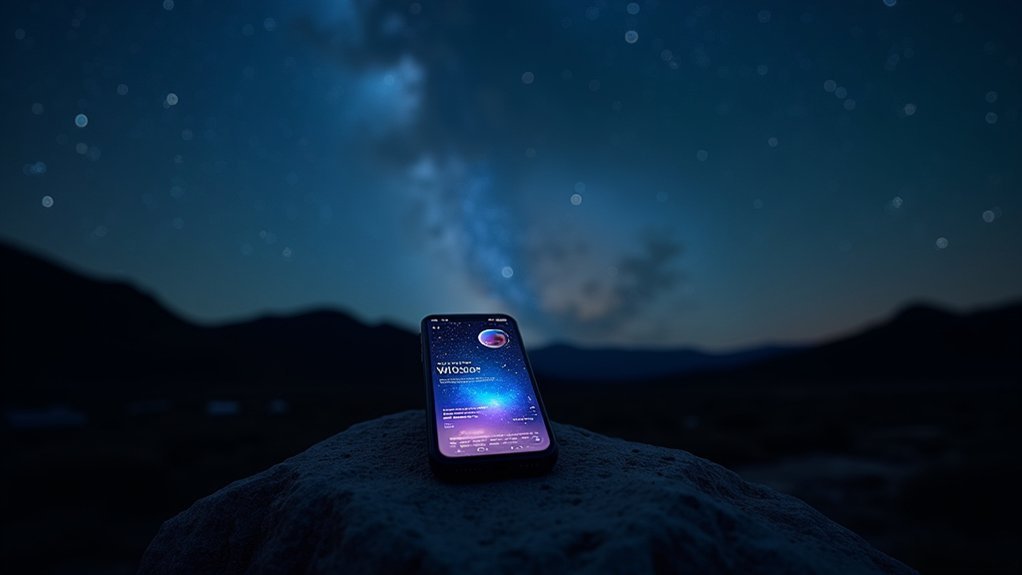Celestial coordinates help you navigate the night sky using two key measurements: Right Ascension (R.A.) and Declination (Dec.). Think of them as space’s longitude and latitude. R.A. runs east-west (measured in hours, 0-24), while Dec. measures north-south positions (in degrees, +90° to -90°). You’ll need these coordinates to point telescopes, use star charts, and locate specific objects. Master these basics, and the entire cosmos becomes your celestial roadmap.
Numeric List of Second-Level Headings

Five essential sections comprise our celestial coordinates guide, each designed to build your understanding systematically.
Here’s what you’ll learn:
- Understanding the Celestial Coordinate System – How the sky’s grid works
- Right Ascension (R.A.) Explained – Measuring east-west positions in hours
- Declination (Dec.) Fundamentals – Charting north-south distances from the celestial equator
- Finding the North and South Poles – Locating the +90° and -90° declination points
- Practical Applications – Using coordinates to locate celestial objects
This structured approach helps you grasp how astronomers pinpoint positions in the sky.
You’ll learn how R.A. measures in hours (0-24h) eastward from the vernal equinox, while Dec. measures angular distance (-90° to +90°) from the celestial equator.
These concepts will transform how you traverse the night sky.
Understanding the Celestial Sphere Concept
Although we recognize Earth orbits in three-dimensional space, the ancient concept of a celestial sphere still provides us with a practical way to map the night sky. This imaginary sphere surrounds Earth, with all celestial objects projected onto its surface.
| Celestial Feature | Coordinates |
|---|---|
| Celestial Equator | 0° declination |
| North Celestial Pole | +90° declination |
| South Celestial Pole | -90° declination |
To locate objects in the night sky, you’ll use a coordinate system similar to Earth’s latitude and longitude. Declination measures angular distance from the celestial equator (like latitude), while Right Ascension (RA) measures eastward angle (similar to longitude). This framework lets you navigate the celestial sphere efficiently, whether you’re stargazing or using telescopes for astronomical observations.
The Relationship Between Earth and Sky Coordinates

Earth’s geographic coordinate system directly translates to the celestial sphere, creating an elegant mapping between our planet and the cosmos.
When you look up, you’re using celestial coordinate systems that mirror Earth’s latitude and longitude. Your position on Earth corresponds with what you see overhead.
Declination (Dec) works like latitude—the celestial equator sits at 0°, with the north celestial pole at +90° and southern celestial pole at -90°.
Right ascension (R.A) functions as celestial longitude, measured in hours (0h to 24h) instead of degrees, with each hour spanning 15° of sky.
Unlike Earth’s fixed grid, celestial coordinates slowly shift due to precession, requiring updates approximately every 50 years to maintain accuracy in your star charts.
Declination: Your Celestial Latitude
When traversing the celestial sphere, declination serves as your cosmic latitude, marking an object’s angular distance north or south of the celestial equator. You’ll express this coordinate in degrees, minutes, and seconds for precision—just as astronomers do with stars like Vega at +38° 47′ 1.3″.
Think of the celestial equator as your baseline at 0°. When you’re looking at celestial objects in the northern sky, you’ll encounter positive declination values ranging up to +90° at the north celestial pole. Conversely, southern objects have negative declination values, reaching -90° at the south celestial pole.
Mastering declination is essential for your stargazing adventures. Combined with right ascension, you’ll have the complete equatorial coordinates needed to locate any object in the night sky.
Right Ascension: Mapping Celestial Longitude

Unlike declination’s degrees, right ascension (RA) uses hours, minutes, and seconds to mark positions across the celestial sphere, with each hour spanning 15 degrees.
You’ll find the zero point of RA at the vernal equinox, where the Sun crosses the celestial equator in March, serving as the cosmic equivalent of Earth’s Prime Meridian.
When you’re locating objects in the night sky, remember that RA increases eastward from 0 to 24 hours, creating a complete circular mapping system around our celestial sphere.
Hours Not Degrees
The celestial coordinate system surprises many newcomers when they discover that right ascension (RA) uses hours instead of degrees to measure positions east-west across the sky. This unique approach divides the celestial equator into 24 hours rather than 360 degrees, with each hour equaling 15 degrees of arc.
| RA Conversion | Significance |
|---|---|
| 1 hour | 15 degrees |
| 6 hours | 90 degrees E |
| 12 hours | 180 degrees |
| 18 hours | 270 degrees E |
| 24 hours | Full circle |
When you’re trying to track celestial objects, remember that RA increases eastward from the vernal equinox (0h). For example, locating Vega at 18h 36m 56.3s means finding it about three-quarters of the way around the celestial sphere from the starting point.
Measured From Equinox
Right ascension serves as the celestial equivalent of longitude, anchored at a specific starting point known as the vernal equinox. This zero point (0h RA) marks where the Sun crosses the celestial equator during the March equinox.
When you navigate the night sky, you’re using a coordinate system that’s measured in hours rather than degrees, though each hour equals precisely 15 degrees of rotation around the celestial sphere.
- The vernal equinox point slowly shifts through the zodiac due to Earth’s precession
- Once located in Aries, the zero point now resides in Pisces
- Stars’ RA coordinates help you track their positions as Earth rotates
- The full celestial sphere is divided into 24 hours of right ascension
- You’ll find Polaris near 2h RA and Vega at approximately 18h 36m
Altitude and Azimuth: The Horizon-Based System
Maneuvering the night sky requires a reliable coordinate system, and altitude and azimuth offer a practical horizon-based approach. This system locates celestial objects relative to your specific position on Earth.
Altitude measures how high an object appears above your horizon—from 0° (horizon level) to 90° (directly overhead at the zenith). Azimuth indicates the directional angle along the horizon, measured clockwise from true north: 0° is north, 90° is east, 180° is south, and 270° is west.
Unlike fixed celestial coordinate systems, altitude and azimuth values change as the Earth rotates, making them dependent on your observer’s location and observation time.
You’ll find this system particularly useful with telescopes and star finders when tracking objects during a night’s observation session.
Converting Between Coordinate Systems
You’ll need to master the conversion between equatorial (RA/Dec) and horizontal (altitude/azimuth) coordinates to locate celestial objects from your observation point.
This transformation requires applying spherical trigonometry principles that account for your geographic location, the object’s celestial coordinates, and the specific observation time.
When converting from RA to altitude, remember to multiply RA hours by 15 to obtain degrees, then apply the standard conversion formulas that incorporate your latitude and the object’s hour angle.
Converting Between Coordinate Systems
When observing celestial objects, you’ll often need to convert between coordinate systems to accurately locate them in the night sky.
Converting Right Ascension and Declination to Altitude-Azimuth coordinates requires your specific location and observation time. Remember that RA uses hours (1 hour = 15 degrees) while Azimuth measures clockwise from North in degrees.
To make these conversions, you’ll need:
- Your latitude and longitude as the reference point
- The current date and time for precise positioning
- Local Sidereal Time (LST) calculations for proper alignment
- The object’s coordinates on the celestial sphere
- Spherical trigonometry formulas or astronomy software
This conversion process bridges the gap between how stars are cataloged (RA/Dec) and how you’ll actually point your telescope to find them (Alt/Az).
Equatorial to Horizontal
The equatorial to horizontal conversion represents one of astronomy’s most practical calculations for stargazers. When you’re observing celestial objects, translating Right Ascension and Declination into Azimuth and Altitude helps you physically point your telescope in the correct direction.
To perform this conversion, you’ll need your latitude, the object’s coordinates, and the local sidereal time to calculate hour angle (HA).
| Input | Formula | Output |
|---|---|---|
| RA, Dec, Latitude | A = arctan(sin(HA)/(cos(HA)sin(lat)-tan(Dec)cos(lat))) | Azimuth |
| RA, Dec, Latitude | Alt = arcsin(sin(lat)sin(Dec)+cos(lat)cos(Dec)cos(HA)) | Altitude |
| Local Time | LST – RA | Hour Angle |
The horizontal coordinate system gives you intuitive directions (North, South, East, West), making it invaluable for amateur astronomers. As objects move across the night sky, these coordinates change, requiring regular recalculation.
Spherical Trigonometry Basics
At the heart of astronomical navigation lies spherical trigonometry, a mathematical framework that enables seamless conversion between different celestial coordinate systems.
When you’re looking to transform right ascension and declination coordinates to altitude and azimuth, you’ll need these essential formulas that incorporate your observer’s latitude and the hour angle.
- Picture yourself standing at your location, tilted at your specific latitude angle relative to Earth’s equator.
- Visualize the celestial sphere rotating around you as local sidereal time progresses.
- Imagine tracing arcs across the sky that connect celestial poles, your zenith, and the target object.
- See the hour angle sweeping like a celestial clock hand from your meridian.
- Envision altitude rising from your horizon while azimuth circles around your local compass.
Practical Applications for Stargazers
Armed with celestial coordinates, you’ll transform from casual sky observer to methodical star hunter. Using right ascension (RA) and declination (Dec), you can pinpoint specific celestial objects like the Orion Nebula (RA 05h 35m 24s, Dec -05° 27′ 00″).
This knowledge proves invaluable when using star charts to navigate the night sky.
Go To telescopes make stargazing more accessible – simply input the celestial coordinates and let technology guide your view. You’ll find this particularly useful when tracking newly discovered comets and asteroids.
As you gain experience, you’ll convert RA and Dec to altitude and azimuth coordinates, allowing you to visually track objects across the night sky. This practical application of celestial coordinates empowers you to consistently locate and observe virtually any object in the cosmos.
Using Star Charts and Atlases Effectively
While celestial coordinates provide the mathematical framework for locating objects, star charts and atlases transform these numbers into visual guides you’ll actually use at the telescope.
These tools map the night sky using Right Ascension and Declination coordinates, creating a universal system for finding celestial objects.
Star atlases transform mathematical coordinates into visual roadmaps, guiding astronomers across the celestial sphere with precision.
To use your star atlas effectively:
- Orient the chart to match your viewing direction and time of year
- Locate objects by matching their RA/Dec coordinates (like finding the Orion Nebula at RA 05h 35m 24s, Dec -05° 27′ 00″)
- Choose season-specific charts showing constellations visible during your observing session
- Pay attention to magnitude indicators that reveal a star’s brightness
- Use constellation outlines as landmarks to navigate between objects
With practice, you’ll soon translate those abstract coordinates into breathtaking views through your telescope.
Digital Tools for Celestial Navigation
The digital revolution has transformed celestial navigation from paper charts to interactive experiences that dynamically calculate celestial coordinates. Software like Stellarium offers interactive simulations of the night sky, showing objects in real-time based on your location.
Mobile apps such as SkySafari let you identify celestial bodies by simply pointing your smartphone skyward, using RA and Dec coordinates for precise tracking. When planning observations, Cartes du Ciel enables creation of customized star maps for specific coordinates.
For deeper exploration, NASA’s Eyes on the Solar System provides 3D visualization of celestial movements relative to Earth.
Modern GoTo telescopes further simplify navigation with built-in databases—just input coordinates, and the telescope automatically locates your target. These digital tools have made celestial navigation accessible to astronomers at all levels.
Setting Up Your Telescope Using Coordinates
Once you’ve familiarized yourself with celestial coordinates, properly setting up your telescope becomes the critical bridge between theory and actual stargazing.
Start with polar alignment by locating Polaris, then set your declination circle to 90° for proper calibration. Astronomical coordinates (right ascension and declination) transform your telescope into a powerful celestial navigation tool.
Precision polar alignment unlocks the universe, turning celestial coordinates into tangible cosmic discoveries at your fingertips.
- Your telescope’s RA circle rotating smoothly as you track across star-filled skies
- The bright red glow of Betelgeuse serving as your familiar landmark in the darkness
- Declination settings clicking into place as you zero in on distant galaxies
- The telescope slowly pivoting as you input coordinates for M81’s spiral arms
- Your eye at the eyepiece, watching as invisible celestial objects suddenly materialize
For non-clock-driven telescopes, reset the RA for each new object; clock-driven models maintain sidereal time automatically.
Seasonal Changes in Coordinate Viewing
As Earth orbits the Sun throughout the year, your ability to observe specific celestial coordinates dramatically changes with each passing season.
Winter skies reveal Orion’s distinctive pattern, while summer discloses the Summer Triangle—each visible only during their respective seasons due to our shifting perspective.
The ecliptic’s position varies seasonally, affecting how you’ll locate celestial objects using coordinates. Right ascension values for visible stars change throughout the year, altering their rising and setting times.
While declination remains fairly constant for fixed stars, the celestial equator’s angle relative to your horizon fluctuates seasonally.
To optimize your stargazing, adjust your viewing schedule according to these seasonal changes. Winter’s long nights offer extended visibility for certain coordinates, while summer presents different celestial targets altogether.
Common Mistakes When Using Celestial Coordinates
While using celestial coordinates, you’ll find it easy to confuse Right Ascension with Declination or treat RA as degrees rather than hours.
You’re likely to encounter date-time issues when you forget to account for precession of equinoxes or fail to adjust for local sidereal time.
Your telescope alignment must properly translate between celestial coordinates and your local altitude-azimuth system, otherwise you’ll miss your intended celestial targets.
Confusing Coordinate Systems
Despite their essential role in astronomy, celestial coordinate systems present significant challenges for newcomers to the field.
You’ll often find yourself mixing up the equatorial coordinate system (Right Ascension and declination) with the horizon-based Altitude and Azimuth system. Remember, R.A. is measured in hours (not degrees), while Dec uses degrees—a distinction that trips up many beginners.
- Staring at star charts while your telescope points nowhere near your target galaxy
- Frantically adjusting your mount as your target drifts out of view
- Watching the celestial sphere rotate while your coordinates remain stubbornly incorrect
- Squinting at your smartphone app wondering why it doesn’t match your eyepiece view
- Setting your telescope to coordinates from an outdated catalog, forgetting about precession
Don’t worry—these mistakes are rites of passage for every astronomer!
Date-Time Calculation Errors
Time-related miscalculations represent the most insidious errors in celestial navigation. When setting your telescope’s Right Ascension (R.A), failing to convert between Universal Time (UT) and local time will lead you to miss your target entirely.
Don’t forget to account for Daylight Saving Time, which requires a one-hour adjustment to your calculations.
Many observers overlook precession effects on celestial coordinates. Since stars gradually shift position over time, you’ll need to use the correct epoch (typically J2000) for accurate R.A values.
Remember that each hour of R.A equals 15 degrees of rotation—a conversion error here creates significant positioning mistakes.
After each observing session, always reset your R.A settings on non-clock driven telescopes. This simple step prevents confusion when you next aim for the heavens.
Improper Telescope Alignment
Accurate celestial coordinates mean little if your telescope isn’t properly aligned. When setting up your instrument, you must first align it with the North Celestial Pole using Polaris as your reference point. Failing to do this creates a cascade of positioning errors that frustrate your stargazing experience.
- Your declination circle must be precisely set to match your target’s celestial latitude.
- Forgetting to reset the Right Ascension when switching objects leads to confusing misalignments.
- Clock-driven mounts require accurate sidereal time or objects will drift from view.
- Reference stars like Betelgeuse provide significant orientation checkpoints during your session.
- Polaris alignment is your foundation—skipping this step guarantees disappointment.
Remember that celestial coordinates work as a system—each component from alignment to setting circles must be properly calibrated for successful navigation of the night sky.
Frequently Asked Questions
How Do You Read Celestial Coordinates?
You read celestial coordinates by finding the Right Ascension (measured in hours:minutes:seconds) and Declination (in degrees:minutes:seconds). They’re like longitude and latitude for the sky, helping you locate objects precisely.
What Is the One Flaw of the Celestial Coordinate System?
The celestial coordinate system’s primary flaw is precession—Earth’s wobble causes coordinates to drift about 50 arcseconds yearly. You’ll need to account for this when using star positions from different epochs for accurate observations.
Are Celestial Coordinates Fixed?
No, celestial coordinates aren’t completely fixed. While they remain stable over short periods, Earth’s axial precession causes them to slowly shift over decades, requiring updates approximately every 50 years to maintain accuracy.
What Are the Four Systems of Celestial Coordinates?
You’ll use four main celestial coordinate systems: Equatorial (RA and Dec), Horizontal (Altitude and Azimuth), Galactic (longitude and latitude), and Ecliptic. Each system serves different needs when you’re observing the night sky.
In Summary
You’ve now taken your first steps into mapping the heavens through celestial coordinates. As you continue stargazing, you’ll find these numerical guideposts increasingly intuitive. Don’t worry if you’re making mistakes—everyone does when starting out. With practice, you’ll soon navigate the night sky with confidence, moving beyond basic star charts to pinpoint even the most elusive celestial objects.





Leave a Reply